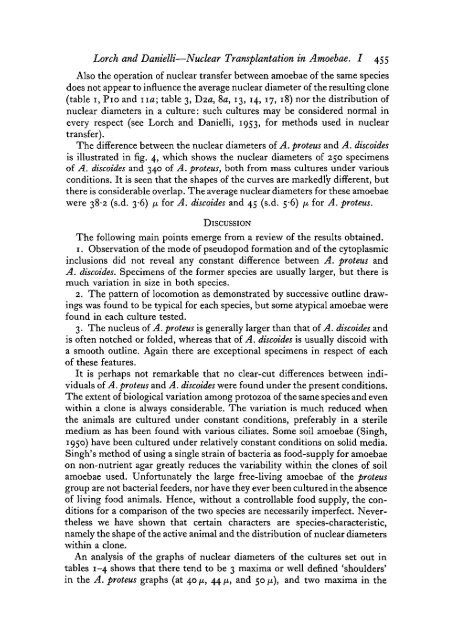Nuclear Transplantation in Amoebae. I. - Journal of Cell Science
Nuclear Transplantation in Amoebae. I. - Journal of Cell Science
Nuclear Transplantation in Amoebae. I. - Journal of Cell Science
Create successful ePaper yourself
Turn your PDF publications into a flip-book with our unique Google optimized e-Paper software.
Lorch and Danielli—<strong>Nuclear</strong> <strong>Transplantation</strong> <strong>in</strong> <strong>Amoebae</strong>. I 455<br />
Also the operation <strong>of</strong> nuclear transfer between amoebae <strong>of</strong> the same species<br />
does not appear to <strong>in</strong>fluence the average nuclear diameter <strong>of</strong> the result<strong>in</strong>g clone<br />
(table i, Pio and 11a; table 3, Dza, 8a, 13, 14, 17, 18) nor the distribution <strong>of</strong><br />
nuclear diameters <strong>in</strong> a culture: such cultures may be considered normal <strong>in</strong><br />
every respect (see Lorch and Danielli, 1953, for methods used <strong>in</strong> nuclear<br />
transfer).<br />
The difference between the nuclear diameters <strong>of</strong> A. proteus and A. discoides<br />
is illustrated <strong>in</strong> fig. 4, which shows the nuclear diameters <strong>of</strong> 250 specimens<br />
<strong>of</strong> A. discoides and 340 <strong>of</strong> A. proteus, both from mass cultures under various<br />
conditions. It is seen that the shapes <strong>of</strong> the curves are markedly different, but<br />
there is considerable overlap. The average nuclear diameters for these amoebae<br />
were 38-2 (s.d. 3-6) p for A. discoides and 45 (s.d. 5-6) /u, for A. proteus.<br />
DISCUSSION<br />
The follow<strong>in</strong>g ma<strong>in</strong> po<strong>in</strong>ts emerge from a review <strong>of</strong> the results obta<strong>in</strong>ed.<br />
1. Observation <strong>of</strong> the mode <strong>of</strong> pseudopod formation and <strong>of</strong> the cytoplasmic<br />
<strong>in</strong>clusions did not reveal any constant difference between A. proteus and<br />
A. discoides. Specimens <strong>of</strong> the former species are usually larger, but there is<br />
much variation <strong>in</strong> size <strong>in</strong> both species.<br />
2. The pattern <strong>of</strong> locomotion as demonstrated by successive outl<strong>in</strong>e draw<strong>in</strong>gs<br />
was found to be typical for each species, but some atypical amoebae were<br />
found <strong>in</strong> each culture tested.<br />
3. The nucleus <strong>of</strong> A. proteus is generally larger than that <strong>of</strong> A. discoides and<br />
is <strong>of</strong>ten notched or folded, whereas that <strong>of</strong> A. discoides is usually discoid with<br />
a smooth outl<strong>in</strong>e. Aga<strong>in</strong> there are exceptional specimens <strong>in</strong> respect <strong>of</strong> each<br />
<strong>of</strong> these features.<br />
It is perhaps not remarkable that no clear-cut differences between <strong>in</strong>dividuals<br />
<strong>of</strong> A. proteus and A. discoides were found under the present conditions.<br />
The extent <strong>of</strong> biological variation among protozoa <strong>of</strong> the same species and even<br />
with<strong>in</strong> a clone is always considerable. The variation is much reduced when<br />
the animals are cultured under constant conditions, preferably <strong>in</strong> a sterile<br />
medium as has been found with various ciliates. Some soil amoebae (S<strong>in</strong>gh,<br />
1950) have been cultured under relatively constant conditions on solid media.<br />
S<strong>in</strong>gh's method <strong>of</strong> us<strong>in</strong>g a s<strong>in</strong>gle stra<strong>in</strong> <strong>of</strong> bacteria as food-supply for amoebae<br />
on non-nutrient agar greatly reduces the variability with<strong>in</strong> the clones <strong>of</strong> soil<br />
amoebae used. Unfortunately the large free-liv<strong>in</strong>g amoebae <strong>of</strong> the proteus<br />
group are not bacterial feeders, nor have they ever been cultured <strong>in</strong> the absence<br />
<strong>of</strong> liv<strong>in</strong>g food animals. Hence, without a controllable food supply, the conditions<br />
for a comparison <strong>of</strong> the two species are necessarily imperfect. Nevertheless<br />
we have shown that certa<strong>in</strong> characters are species-characteristic,<br />
namely the shape <strong>of</strong> the active animal and the distribution <strong>of</strong> nuclear diameters<br />
with<strong>in</strong> a clone.<br />
An analysis <strong>of</strong> the graphs <strong>of</strong> nuclear diameters <strong>of</strong> the cultures set out <strong>in</strong><br />
tables 1-4 shows that there tend to be 3 maxima or well def<strong>in</strong>ed 'shoulders'<br />
<strong>in</strong> the A. proteus graphs (at 40 p, 44 ft, and 50 p), and two maxima <strong>in</strong> the
















